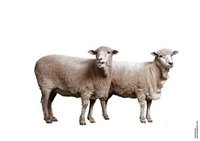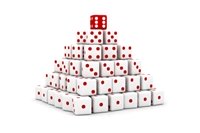|
History of Dice The history of dice is almost as old as mankind itself. They are the oldest gaming instrument the world has EVER known and are still wildly popular today. Let's see if the Nintendo Wii can beat that longevity streak. I find it amazing that everyone from the ancient Egyptians and Chinese to the Aztecs and Africans all played with them. It must be true: Great minds think alike. Early HistoryThe ancient ancestor of the modern die is the knucklebone, or astragal. No, I didn't say Astro-Gal. That sounds like a super heroine. By definition, astragal refers to the anklebone of a sheep or other cloven footed animal.Who knew that the world's oldest gaming device would originate from a sheep?
Historians think early man used them as magical devices to deduce the future. Life was tough back then. Our ancestors must have figured that some good news from the future would cheer them up.
Greek and Roman TimesGreek mythology indicated that Zeus, Poseidon and Hades gambled with an astragal. Why? Well, to divide up control of the earth, of course! In ancient Rome, one of the popular Roman games was called “Ten”. It is still played in Europe and known as “Passe-Dix”.In these times, dice were made from mostly bone and ivory. However Greeks and Romans constructed them from bronze, onyx, marble and amber too. History of Dice: Native American Games in North AmericaFrom a historical perspective, explorers Lewis & Clark contributed to the history of dice. They documented Native American games on their travels across North America in the early 1800s. Granted, that wasn't their primary objective for such an extraordinary trip. However, we're sure glad they did it! Native American women enjoyed dice games as much, if not more, than the men. Dice were carved from antler or bone or the pits of fruit. Traditional Native American games often involved throwing the dice into a bowl, like in a game known to some as Hubbubb. Native Americans also used decorative, 4 sided stick dice in their games. Native American gaming included a wide variety of different types of games. History of Popular GamesCraps is the descendant of an ancient Arab game called Hazard. It wasn't invented by the Dukes of Hazzard either. However, General Lee's (no not the orange car from the TV show) Confederate soldiers in the American Civil War may have played it. Authentic Civil War dice still exist, so we know dice were a popular pastime. It has been said that the name craps is derived from the French pronunciation of the word "crabs." Here’s a time line of the evolution of craps in the history of dice:
*Hazard was introduced to Europe in the eighth century. Recently featured in the Pirates of the Caribbean movie with Johnny Depp, liar's dice has a long history too. It turns out, Spanish explorers likely learned the game from the ancient Incans, who called it Perudo or Dudo, during travels to Latin and South America. It is a good thing too, because I'm sure that liars dice provided great entertainment on the long voyage back home. Speaking of the sea, sailors and fishermen from Northern France are credited with creating another popular dice game: Shut the Box. The history of this game indicates the game originated there and grew into a popular pub game in England. History of CheatingYes, our ancestors cheated. According to the history of dice, it was not just the farmers,soldiers or merchants, but emperors, generals and politicians. Wait, politicians cheated? Shocking. I know.It seems that cheating has a long history too. Written records in India dating back to 1500 BC, the Vedic hymns, reference cheating with loaded dice or trick boxes. I'm not sure that hymn is available on iTunes, but a museum may have a written copy it. Any die that is not a perfect cube is called a “shape”. Shapes are shaved down on 1 side or more. As a result, they tend to settle on their larger surfaces. These are the most commonly found crooked die. It will not follow the correct math odds when rolled. Not to confuse you, but a "loaded" die may be shaped like a perfect cube. But, below the surface it is weighted down on 1 side. Have you seen the movie Ocean's 13? They used loaded dice in their revenge scheme. To keep it simple, think of it this way: All loaded die are crooked, but not all crooked die are loaded. Archaeologists found evidence of cheating dice in ancient Egypt, Asia and North and South America. They also recovered loaded dice from the ruins of Pompeii, Italy. Devious minds think alike too, it seems. Present DayYou’ll find them in casinos, board games and video games. They’re referenced or revered throughout popular culture. Terminology has become lingo. Phrases like “roll the dice” or “no dice” appear often in writings, lyrics and every day conversation.They are thousands of years old, yet as popular as ever.
ReferencesI’d be misleading you if I did not to tell you about the sources of information that helped provide facts on this roll through the history of dice.1.Encyclopedia Britannica, Volume 4, 15th Edition (2005). - You can find it in your local library! 2.Jacobs, Gil; World’s Best Dice Games: How to Play and Win (1981), John N. Hanson Co., Inc.
Gil Jacobs' book, the World's Best Dice Games provides great information for all fans of dice. It details the history of dice, games, strategies, odds and terminology. Written with a friendly and fun style, I highly recommend it. It is definitely worth a look. Dice on Display Back to All About Dice Home Page
|




